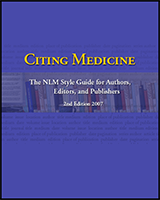Box 72Organizations as author/editor
An organization such as a university, society, association, corporation,
or governmental body may serve as an author or editor.
Omit "The" preceding an organizational name
If a division or another part of an organization is included
in the publication, give the parts of the name in descending
hierarchical order, separated by commas
American
Medical Association, Committee on
Ethics.
International Union of Pure and Applied
Chemistry, Organic and Biomolecular Chemistry
Division.
American College of Surgeons, Committee on
Trauma, Ad Hoc Subcommittee on Outcomes, Working
Group.
When citing organizations that are national bodies such as
government agencies, if a nationality is not part of the
name, place the country in parentheses after the name, using
the two-letter ISO country code (see
Appendix D)
Separate two or more different organizations by a
semicolon
Canadian Association of Orthodontists;
Canadian Dental
Association.
American Academy of Pediatrics, Committee on
Pediatric Emergency Medicine; American College of
Emergency Physicians, Pediatric
Committee.
If both individuals and an organization or organizations
appear on the title page of a book as authors, use the names
of the individuals as the author. Give the organization at
the end of the reference as a note, if desired.
For names of organizations not in English:
Give names
in languages using the roman alphabet (primarily
European languages, such as French, Italian,
Spanish, German, Swedish, etc.) as they appear in
the publication. Whenever possible follow a
non-English name with a translation. Place all
translations in square brackets.
Istituto di Fisiologia Clinica del
CNR.
Universitatsmedizin
Berlin.
Nordisk Anaestesiologisk Forening
[Scandinavian Society of
Anaesthesiologists].
Romanize (write in the roman
alphabet) or translate names of organizations in
Cyrillic, Greek, Arabic, Hebrew, or Korean. A good
authority for romanization is the
ALA-LC Romanization Tables.
Whenever possible follow a non-English name with a
translation. Place all translations in square
brackets.
Translate names of organizations in
character-based languages such as Chinese and
Japanese. Place all translations in square
brackets.
Ignore diacritics, accents, and
special characters in names. This rule ignores
some conventions used in non-English languages to
simplify rules for English-language
publications.
Treat letters marked with
diacritics or accents as if they are not
marked
Å treated
as A
Ø treated
as O
Ç treated
as C
Ł treated
as L
à treated
as a
ĝ treated
as g
ñ treated
as n
ü treated
as u
Treat two or more letters printed
as a unit (ligated letters) as if they are two
letters
æ treated
as ae
œ treated
as oe
